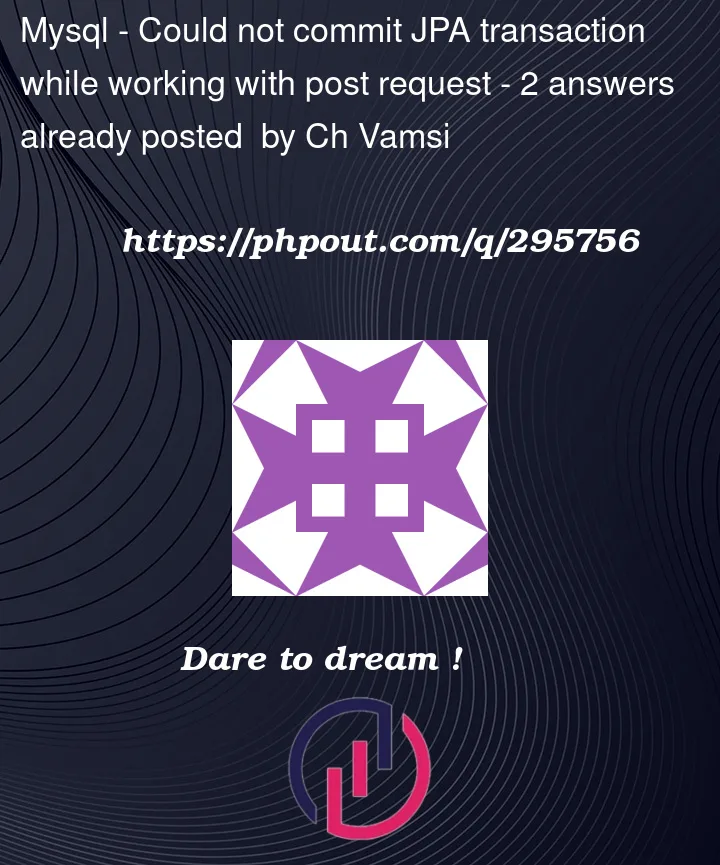I’m attempting to send a post request with an image attachment and employee details in json format. For ImageData and Employee, I have distinct tables. I am able to store image data with my code, but not employee data.The error message "Could not commit JPA transaction" is displayed.
Here I am sharing my code details
#Post Request
@PostMapping("/create")
public Employee tempCreateEmployee(
@RequestParam("json") String json,
@RequestParam("file") MultipartFile file
) throws CustomException {
try {
ObjectMapper objectMapper = new ObjectMapper();
logger.info("data received as string");
Employee employee = objectMapper.readValue(json, Employee.class);
logger.info(employee.toString());
logger.info("Received employee data: {}", employee);
int imageId=fileService.uploadImageFile(file);
logger.info("file processing successful");
employee.setImageid(imageId);
logger.info(employee.toString());
return employeeService.save(employee);
} catch (Exception ex) {
throw new CustomException("Employee object not created");
}
}
Service method for uploading image
public int uploadImageFile(MultipartFile file) throws IOException {
ImageData imageData= filesRepo.save(ImageData.builder()
.name(file.getOriginalFilename())
.type(file.getContentType())
.id(filesRepo.findAll().size()+1)
.image_filedata(ImageUtils.compressImage(file.getBytes())).build());
return imageData.getId();
}
Employee Model class:
package com.SpringTask.SpringTask.Models;
import com.SpringTask.SpringTask.Encryption.Encrypt;
import com.fasterxml.jackson.annotation.JsonFormat;
import jakarta.persistence.*;
import jakarta.validation.constraints.*;
import jdk.jfr.DataAmount;
import java.time.LocalDate;
import java.time.format.DateTimeFormatter;
import java.util.Date;
import lombok.*;
@AllArgsConstructor
@NoArgsConstructor
@Builder
@Setter
@Getter
@Data
@Entity
@Table(name="tableEmployees")
public class Employee {
@Id
@GeneratedValue
public Integer id;
public String firstName;
public String lastName;
public String address;
public String email;
public int phoneNumber;
private int imageid;
}
ImageData model class:
package com.SpringTask.SpringTask.Models;
import jakarta.persistence.*;
import jakarta.persistence.Table;
import lombok.AllArgsConstructor;
import lombok.Builder;
import lombok.*;
import lombok.NoArgsConstructor;
import org.hibernate.engine.internal.Cascade;
import java.util.Arrays;
@Entity
@Table(name = "tableImageData")
@Builder(toBuilder = true)
@Data
@AllArgsConstructor
@NoArgsConstructor
@Setter
@Getter
public class ImageData {
@Id
private int id;
private String name;
private String type;
@Lob
@Column(name = "image_filedata", columnDefinition = "LONGBLOB")
private byte[] image_filedata;
}
I’ve tried debugging , but every time same issue appears. I have verified my database setup and code logic.
Could not commit JPA transaction means?





2
Answers
enter image description here
When sending a request in your postman, you can try to send your data via raw and json model in Body.
You need to share your JSON data and
EmployeeServiceclass to understand the issue better.From the image you shared, I found out one issue:
You give
idfor creating an employee but in theEmployeemodel, it is generated by Hibernate automatically in your model by specifying this:@GeneratedValue. So it is wrong, you should not add id field in your JSON data. That might be the reason for getting the error.If you want to give
idexternally, then you need to remove@GeneratedValueannotation inEmployeeclass.